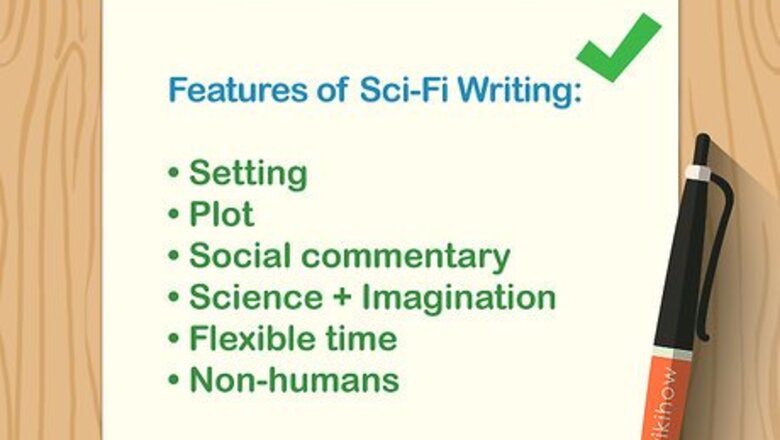
views
Finding Story Inspiration
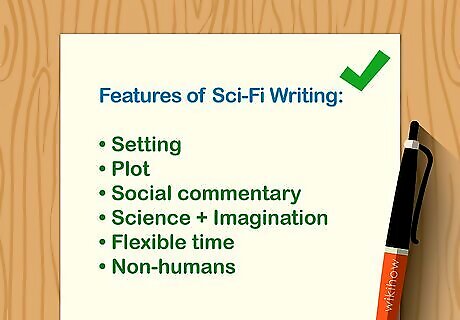
Read old and new science fiction writers to see what ideas have been done. Go to your local library or bookstore and browse the science fiction section. Read the back cover blurbs to see what stories they’ve written, and read through the whole book if it interests you. This way, you’ll get an idea of how to write effectively in the genre. Try authors like Ray Bradbury, H.G. Wells, Isaac Asimov, and Andy Weir. Ask an English teacher or a librarian for suggestions on books or authors. Read writers for the format that you want to write, such as screenwriters if you want to do a screenplay or short story writers for a short story.

Watch science fiction movies to get visually inspired. Find movies with premises that interest you and take a few hours to watch them. Write notes on what set pieces or ideas you like so you can reference them later when you’re writing. Listen to the dialogue to get a sense of how your characters should speak. Watch older movies like Jurassic Park, Blade Runner, Alien, or Star Wars, as well as new movies like The Martian, Ex Machina, Interstellar, and Arrival.

Look online or scientific journals for recent breakthroughs. When new discoveries are made, they’re often published in many magazines or journals. Go to your local newsstand to find scientific publications and page through them. Write down any discoveries or articles that are interesting so you can incorporate the ideas into your writing. Look for journals that cover multiple areas of science, such as Nature or Science. See if you can subscribe to a digital version or archive of the journal if you want to access them easier.

Stay up to date with current world news to get real-life inspiration. If you plan on writing a science fiction story that takes place in the future, use events currently happening in the world to help shape your universe. Watch or listen to news from around the world to get your inspiration. This could help you develop a realistic future, or even something you could incorporate into a world of your own. For example, if news came out about the discovery of a new supervirus, you could write a story about the last few survivors or how finding a cure went wrong.

Use the “What if…” thesis model to generate a story premise. Ask yourself questions like “What if this happened?” or “What if this were possible?” Brainstorm ideas based on your research or inspiration to get your ideas on paper. Mark the ideas that you think are strong and expand them into a few sentences detailing your story. For example, the “What if” question for Jurassic Park is “What if dinosaurs were brought back to life for our entertainment?”
Building a Sci-Fi Setting

Choose a time period for your story. Even though science fiction usually takes place in the future, you can create sci-fi for any time period. Perhaps you want aliens to invade a small town in the 50s or make a time travel story that goes into the past. Think about what time works best for your story and use it as your setting. Using the far, far future will give you the most freedom to explore ideas while setting your story in the past will restrict you. If you set a story in the past, make sure to research the time period to see what technology existed, what events were taking place, and how people spoke. Check for what clothing they wore and what customs they followed.

Research real locations and their histories to incorporate into your world. Even if your story takes place on a distant planet, take influence from cultures and events here on Earth. This will add more relatability to your story and make the world seem more grounded and real. For example, The Handmaid’s Tale is a futuristic society, but the themes of treatment of women and slavery come from real culture. Experiment with mixing different cultural practices when creating an alien race. For example, you may blend a nomadic culture that dresses like the Vikings.

Incorporate real science into how your world functions. Even if you want people to fly, you should explain how and why they can. Keep most of your science loosely based in reality so readers have a familiar thing to latch onto. If not, they may get lost in the universe you’re creating. If you’re introducing new technology that is completely foreign to readers, make sure to describe it in detail so they understand it. For example, The Martian uses real science to send a man to Mars and for how he’s able to survive once he’s stranded.
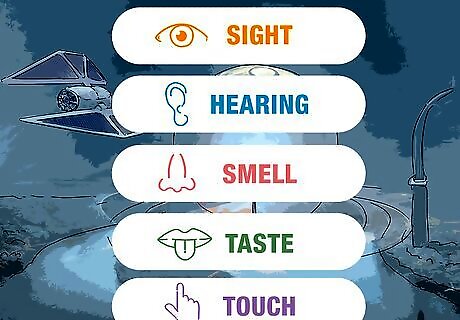
Consider all 5 senses when describing your settings. Think about what characters in your story would see, hear, feel, taste, and smell. This will help you create a more vivid setting that readers will imagine the location better and feel like they are a part of it. Make lists of what your characters would experience when they first arrive in your setting. What sights would they see? Who would be there? For example, if your story takes place in a world where the oceans dried up, you could describe the heat, the taste and smell of salt in the air, and the large salt deposits and valleys where the oceans once were.

Write descriptions for each of your settings so you have an understanding of them. Work on brief paragraphs describing the landscape, people, culture, and animals for each of the locations you want to include. Think about the major set pieces in the locations and how the characters interact with them. If you need to get more detailed about wildlife or special quirks about your world, expand your notes further. For example, if you were going to do a brief description of Pandora from the movie Avatar, you may write: “Pandora is a large jungle planet inhabited by a tall, blue humanoid race called the Na’vi. The Na’vi exist in a tribal society with chiefs and spiritual leaders guiding them. They worship and bond with the lush and colorful wildlife around them.”
Creating Memorable Characters
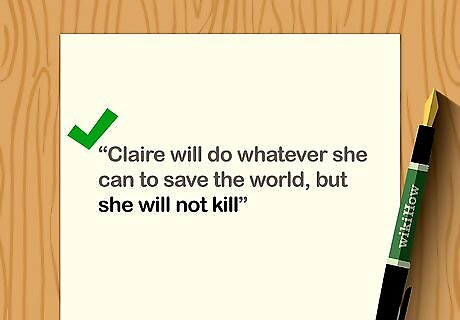
Make your protagonist have flaws. Even though a hero sounds like they should be perfect, giving them something that holds them back will help readers empathize with them. Maybe your hero will do anything to save their life, even if it involves killing someone or maybe they’re selfish and only care about themselves. Brainstorm common personal flaws and pick one for your character. For example, Superman’s flaw is that he’ll do whatever he can to save the world, but he will not kill. Putting him in a situation where he may have to harm someone makes your hero go through an interesting choice and keeps the reader on the edge of their seat.
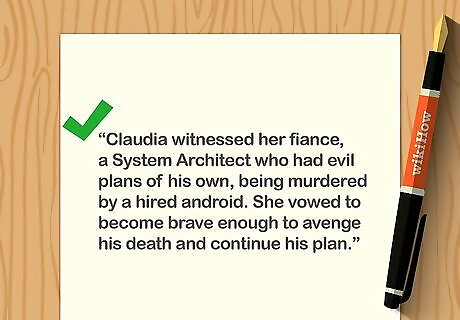
Let your antagonist have some redeeming qualities. Just like how heroes can’t be entirely good, your villain of the story can’t be completely bad. An evil villain just for the sake of being evil makes your character flat and uninteresting. Give the antagonist a redeeming quality, such as doing what they need to save their child, so a reader can sympathize with them. For example, HAL from 2001: A Space Odyssey sees the human crew endangering their mission and chooses to wipe them out. Remember that the villain is often the hero of their own story. If your villain is a monster, they do not need to have a redeeming quality, but it could be interesting if they do. Consider having a monster feed its children rather than hunting people for fun.
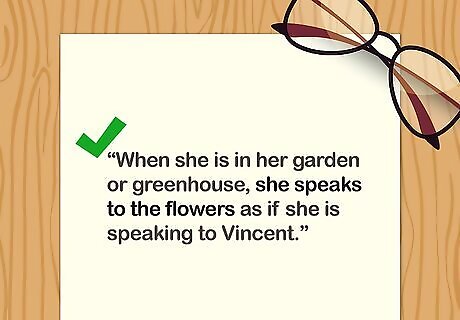
Create small quirks that your characters perform out of habit or necessity. Quirks are small actions your characters perform that may seem odd at first, but serve a purpose that leads to a better understanding of who your character is. Maybe they constantly check their weapon because they’re cautious or they’ve lost it in the past. Whether you explain the quirks or not, make them believable in your universe. If your character has an especially odd quirk, like having to pour water on themselves to stay hydrated, you may need to explain it so readers aren’t left in the dark.

Give your characters goals and motivations that are relatable. The motivations of your characters are the driving forces of your story and allow readers to empathize with them. Think about why your characters are doing those specific actions and what they want to achieve overall. Consider how you would act in a similar situation so you can ground it in reality and make the characters act in a believable way. For example, a character may be motivated to travel across the universe to find a cure for a rare disease in their homeworld.
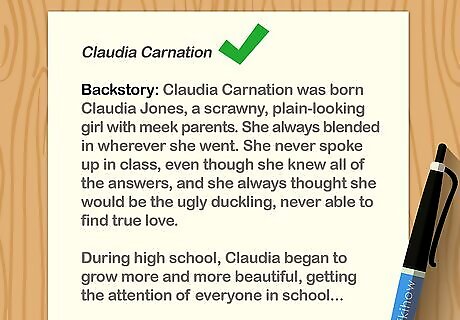
Write your characters’ backstories if they help you figure out who they are. Though you don’t need to include their backstories in the piece you’re writing, it may help you develop your character on a deeper level. Write down their name, age, where they came from, how they were raised, and what life-changing events they’ve experienced. Aim to have a few paragraphs for each of your main characters. Sketch out what you want your character to look like if they’re an alien race or unfamiliar to a general audience.
Writing Your Story
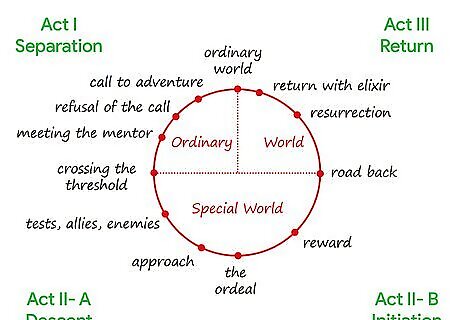
Use “The Hero’s Journey” template for storytelling. A Hero’s Journey is a common storytelling device to make sure your main character goes through an emotional rollercoaster throughout your writing. Your hero starts in their ordinary and comfortable world, but something or someone makes them go out of their comfort zone. Throughout the story, they will hit their rock bottom before redeeming themselves and saving the day. Work through the 12 steps of The Hero’s Journey for your protagonist. You can find the 12 steps of the Hero’s Journey here: http://www.tlu.ee/~rajaleid/montaazh/Hero's%20Journey%20Arch.pdf. The Hero’s Journey is not a set in stone way to write stories, but it will help guide you if this is the first time you’ve written. This works best in long-form writing, like a novel or screenplay.
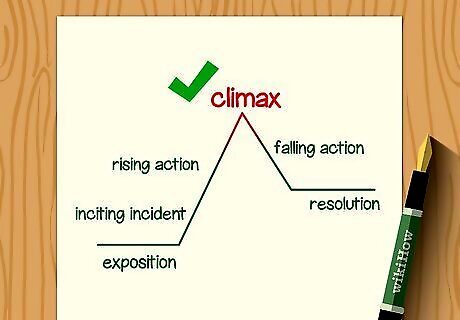
Outline your entire story so you know what to write. Start by writing a summary of your story in 1 paragraph. Use each sentence to explain the most important parts of your story. Then, take each sentence of your paragraph and expand it into greater detail. Keep working backward to add more detail to your story. This is known as the “snowflake method” of outlining.

Choose a first or third person point of view. Determine if you want your story to focus on one character or if you want a reader to experience many different points of view. If you choose first person, you would use “I” statements and you’re restricted to what your main character can see and think. For third person, you would use “they/them” statements and use a narrator to tell the story. A third person limited point of view allows you to write as a narrator, but the reader only gets the thoughts and feelings of your protagonist. A third person omniscient point of view uses a narrator, but you can switch to the thoughts and feelings of any character in your story. While you can use second person, where the reader is the protagonist and the word “you” is used, it is not very common.
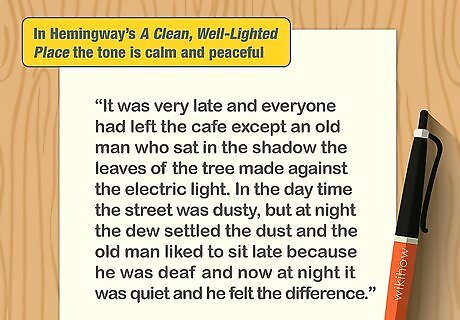
Find a tone of voice for your writing. Your voice is what makes your writing unique and will set you apart from other writers. Use your own life experiences and language to help shape the way you write so readers can experience how you tell a story. Your voice will depend on what point of view you’re using. Examples of tone include sarcastic, enthusiastic, indifferent, mysterious, wry, somber, acerbic, smug, pessimistic, and so on. The tone can also be formal or informal. Your writing’s voice can be shaped by what point of view you’ve written your work. For example, you may be able to use more slang or informal language if you’re writing in the first person.

Work on writing believable dialogue. Take each character’s upbringing, education, age, and career into consideration when you make your characters speak. Avoid using dialogue to info dump in stilted or unnatural language. Make sure each of your characters sounds different or else your readers will have a hard time telling which character is speaking. Avoid clichès like, “Are you thinking what I’m thinking?” or “I have a bad feeling about this.” Listen to how people talk in real life so you have an idea of how people speak. Ask if you can record a conversation and try to transcribe the audio.
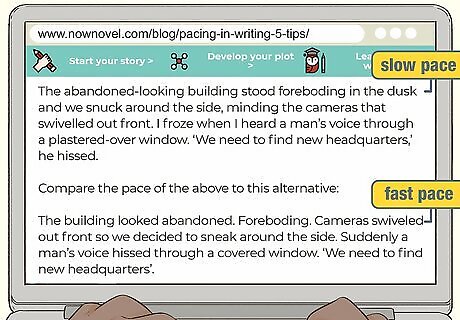
Pace your story so action happens frequently. Think of your story happening in 3 acts, where the first act is what makes your protagonist go on the adventure, the second act is developing the conflict, and the third act is the resolution. You can quicken or slow your pacing by using shorter and longer chapters, adding details, or shifting to subplots. Use detailed language, but don’t be over-explanatory or else you risk bogging down your writing. Vary the length of the sentences throughout the piece. Shorter sentences are read faster. Longer sentences, like this one, will make it seem like the story is going slower and will affect how readers feel while reading your story.

Write until you feel like your story is complete. Science fiction novels tend to be around 100,000 words when they’re finished, but don’t let that be a hard and fast rule. Ask yourself if you hit all the story points you wanted to or if everything was explained well. If you answer yes to these questions, you’re done! Ask others to read your story so you can get a different perspective on your writing. They may catch things that you may not have noticed.

Revise your first draft after reading through it. Take a break from your first draft for a few weeks or a month to get some space from your story. Open your first draft and then start a new document to work on a blank page. Take any notes you or people you had read the story have made and make the necessary changes to your story. Make multiple revisions until you feel like your story is completely finished. Find an editor or copywriter if you can to help look over and revise your drafts.




















Comments
0 comment